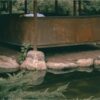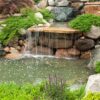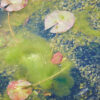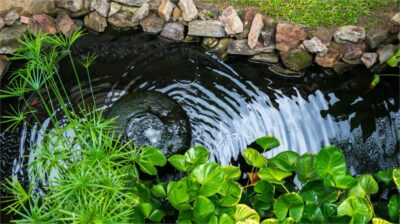HOW TO FILL A POND WITH WATER?
Have you decided on installing a naturistic, aesthetically pleasing pond in your backyard? Great! We salute your taste in elegance. Now’s the time to fill it up with water. Today, we are here to help you with just that!

Backyard ponds boast of your beauteous sense in home-scaping and add a glow to your otherwise somber-looking backyards. Ponds, especially fish ponds or koi ponds, are destined to be the envy of all your visitors because of their uncanny grace and elegance. Ponds make you realize how peacefully soothing life can be.
Backyard ponds make you forget all about your worries as they engulf you into their serene. Having a pond on your property reduces stress and anxiety levels and is a tranquil escape from reality. The second step towards building a pond is filling it with water – the first one is obviously building it in the first place!

Things you should know before filling your pond with water
Before we go heads down into the process of filling a pond with water, we first need to know a few important things.
Keeping the pond water clean
You need to keep the water of your pond clean at all times if you’re considering building a pond. Using a net or a skimmer, skim the leaves that fall into the pond. A waterfall may help to manage the flow of water while also beautifying the pond. Extra pond tinting will aid in keeping the water cool throughout the hot summer months.
Also, avoid overfeeding and overfertilizing the fish and plants since this can contaminate the water and have a negative impact on the ecosystem of your pond.
Shielding your pond
To protect your pond against outside elements, you need to shield it. You can add a fence around your newly built backyard pond to avoid uninvited people from coming near your pond and saving yourself from potential liability claims. Fences also protect your koi fish and any other wildlife that may be thriving inside your pond from predators.
Moreover, your pond should also have predator protection for your fish – someplace where your aquatic creatures may hide when threatened by predators. You can add spiraling fish tunnels, nets (spread over the pond), and decoys to provide a safe haven for your fish and other creatures.
Using biology and beneficial bacteria to your aid
When you first fill up a pond, it’s like a blank piece of paper – an ecosystem with no microbes. Bacteria decompose fish waste and organic waste, keeping the water clean and free of ammonia. Ammonia enters pond water via fish excrement and gills. Because a new pond lacks microorganisms, it is vulnerable to growing ammonia levels, and this increase in ammonia levels can be harmful to fish.
Nitroso Pira bacteria regulate ammonia levels by converting ammonia to nitrite and then to nitrate. Nitrate is the final product, which is not hazardous to any aquatic organism and is absorbed by pond plants and algae.
You may develop this amazingly advantageous bacteria by simply adding stones, sand, and gravel from an established pond, as well as, of course, a suitable filter and a good pond liner. Add additional Nitroso Pira from another pond if you want more. If you don’t have any nearby, you may buy refrigerated Nitroso Pira at any aquarium store.
Another thing to remember is that it is ideal for releasing only a few little fish at a time since more fish means more ammonia. When the pond has established itself, you can add more fish later.
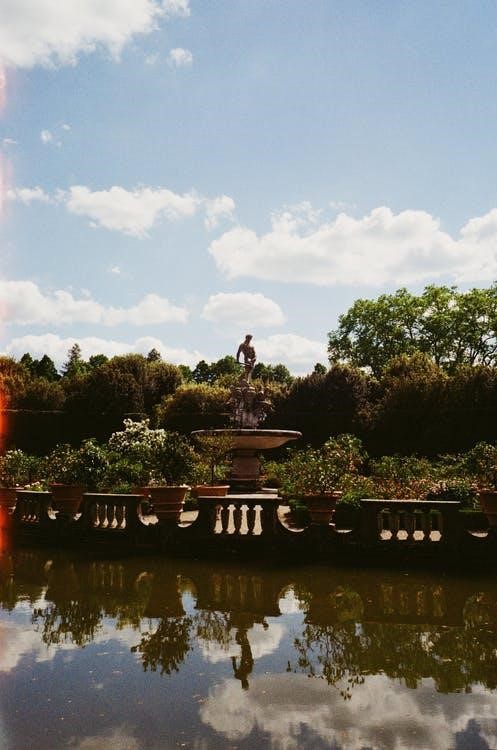
Filling a pond with water – a step by step guide
Once you’ve built a pond on your land, it’s time to make the pond functioning.

1. Dig, dig, dig!
The very first step in filling a pond is to dig a big hole. Choose a somewhat shaded location with at least five to six hours of sunshine. That way, it will be cozy and pleasant around your pond. Mark the desired location with a cable or water pipe. Then excavate the pond, making sure that the edges are level on both sides.
2. Working with the stones
After you’ve dug the hole, climb in there your pond and remove any large or jagged stones to avoid damaging the pond liner you’re about to install. Put down at least a 5cm deep layer of sand at the bottom to prevent any seeds from shooting before their time.
3. Hello, pond liner!
Once you’re done with all the grunt work mentioned above, it’s time to add a pond liner to your beautiful pond. Put the pond liner into an opening and carefully arrange it all around the pond. It would be best if you chopped off any extra pond liner. Fill the bottom with sand and stones and place the liner on top.
4. Splash! Here comes the water
After the pond liner has been put, the fun chapter begins – filling your pond with water. This is the most important step in constructing your simple pond, so do it correctly. Make sure to keep an eye on your pond as it fills to ensure it grows into the pattern you choose.
Filling the pond with water may be the sole step that takes longer than the others. The majority of ponds are naturally filled with rainwater. Filling your pond with rainwater may seem like a good option while being financially feasible at the same time; however, this may require a lot of time and dependability on rain forecasts.
If you want rainwater to be your source of pond water, build the pond during the rainy season or during a time when precipitation is most expected. It might require a heavily savage rainfall to fill up your entire fish pond.
If the option of filling your fish pond with rainwater doesn’t seem to resonate with you, don’t worry; there are alternatives.
You have the option of using hose water or pumping water from a local brook or river. When utilizing hose water, you should always use a filter. A filter helps to filter out any dust or other debris from entering your pond and polluting it before it even gets a chance to function.

5. Attention to the pond edges
The liner will expand somewhat after filling the pond with water, and what you’ll need to do is fill in the gaps with dirt and stones. Another thing to bear in mind is that the material of the liner degrades when exposed to sunlight. As a result, make certain that the unprotected portions are not left bare for an extended period of time.
6. Greenery and flora
Now it’s time to start filling the pond with greens. Plants, apart from their beauty, work as a natural filter in water bodies like ponds. They provide color and texture to the pond, giving it ‘personality’ and ‘feel.’ Plants, greenery, and flora absorb nitrates as fertilizer in pond water, limiting nitrogen level and algal development.
Aquatic plants can be planted roughly 1-2 weeks after you’re filling your pond with water. While on the lookout for the best aquatic pond plants, choose ones that are resilient and adaptable to the pond’s living conditions.

7. Adding fish
The final stage in filling in a pond is adding fish and acclimatizing them to their new surroundings. Because the plants are already submerged, the underwater habitat should be ready by the time you choose to add fish to your fish pond.
However, before adding pond fish to your fish pond, ensure that the pH level is between 7.2 and 7.8. Also, the water temperature should be at least 60 degrees Fahrenheit. When everything is in order, the fish can be released after at least three days of filling in the pond with water.

Different ways to fill your pond with water
You can use any of the following methods to fill your pond with water.
● Rainwater
You may gather rainwater and feed it to your pond for an economical solution to a small pond water level in small ponds. This approach will not work as well for bigger ponds, but adding a few gallons of rainfall to your little pond can help raise the water volume.
If you reside in a region where there is minimal precipitation, this plan will not work effectively, and your pond will quickly dry out before it even gets a chance to fill out.
Be mindful of where the water originates from if you decide to collect rainwater and add it to your pond. Roof spillover may contain cleaning solutions or chemicals, which are typically toxic to any plants or animals residing inside your pond.

● Garden hose and tap water
Another method for filling your pond is to run a hose through it until the water level reaches the appropriate level. This is another less expensive option than using professional water providers, but it has a disadvantage.
Many sources of water contain chlorine, which is toxic to many fish if it’s in high concentrations. If your pond contains living organisms, you may test the pH level of your tap water to see if it is healthy for your fish or other creatures thriving inside your pond.
If the chlorine content or other additives in the water are too high, you can purchase a dechlorinating treatment to make the water less unsafe. Even trace levels of substances like chlorine may kill a whole population of fish, which can be quite upsetting for pond owners.
To eliminate impurities from your hose water, you may also wish to use a water conditioner, which removes hazardous compounds like chlorine. The greatest water conditioners are non-toxic to people and can remove salt from tainted water.

● Using water providers
This is one of the high-end options used by pond owners. Using professional water providers isn’t technically on the affordable side and might drill a hole in your pocket. However, this method is much more reliable than other methods and is accompanied by professional help.
Fill away!
Ponds are the life of backyards if you happen to have one in your backyard. Ponds are beautiful, and they are stress-relieving. Filling a pond with water may seem like an arduous task, but it’s pretty achievable and even fun if you happen to know what you’re doing! So, don’t wait; let’s get those ponds filled!
FAQS
Can you just fill in a pond?
So, to fill it in, simply go ahead and do so. Water will be pushed out as dirt is pushed in. Mound the dirt slightly above grade and leave it for at least a few days to allow water to work its way out. At some point, you’ll be able to level it out and plant turf.
How do I empty an old pond?
Using your pond pump is perhaps the simplest way to drain a pond, with submersible ones being the recommended choice owing to simpler drainage. To begin emptying a pond using a submersible pump, just place the out-take hose in your yard or the location where you want the water emptied.
How long do you leave tap water before adding fish in a pond?
To eliminate chlorine, you may be instructed to just let the water alone for 24 hours before exposing it to fish or bacteria.
How long will it take to fill my pond?
If you’re replenishing your pond with a domestic water faucet, the maximum flow rate is likely to be 2.2gpm or roughly 132 gallons per hour. At this rate, running 24 hours a day, it would take 17 months to fill your pond, ignoring evaporation, storm occurrences, and other considerations.
How do I keep my pond full?
Groundwater can assist fill a pond, but in most cases, it isn’t enough to entirely fill a pond; thus, it must be supplemented with something else. Natural springs, if they exist, are an excellent supply of water, and beautifully running springs will keep the pond filled with a steady flow of clean water.


